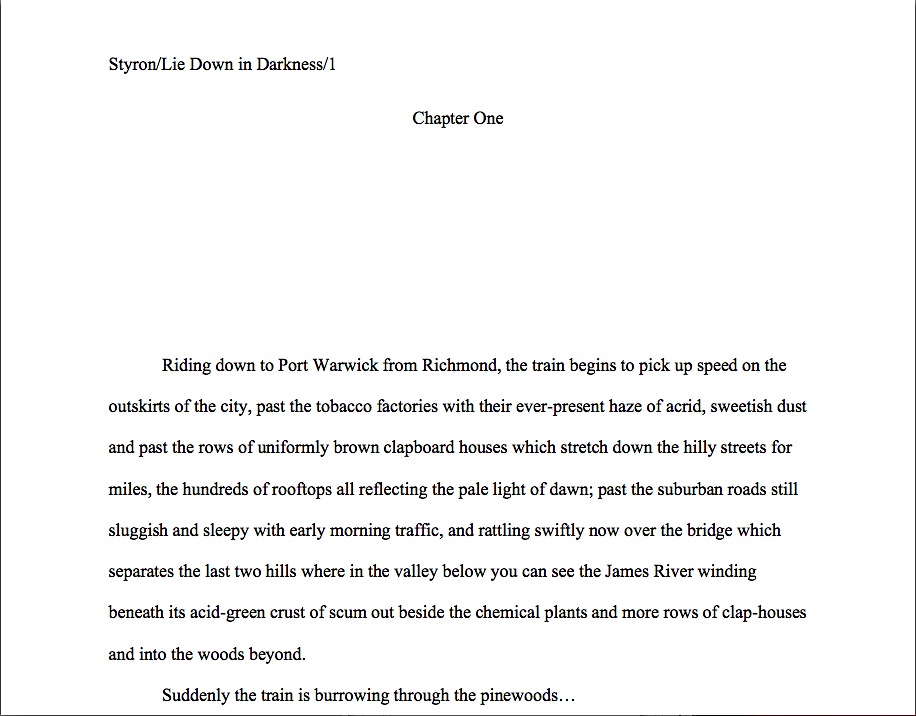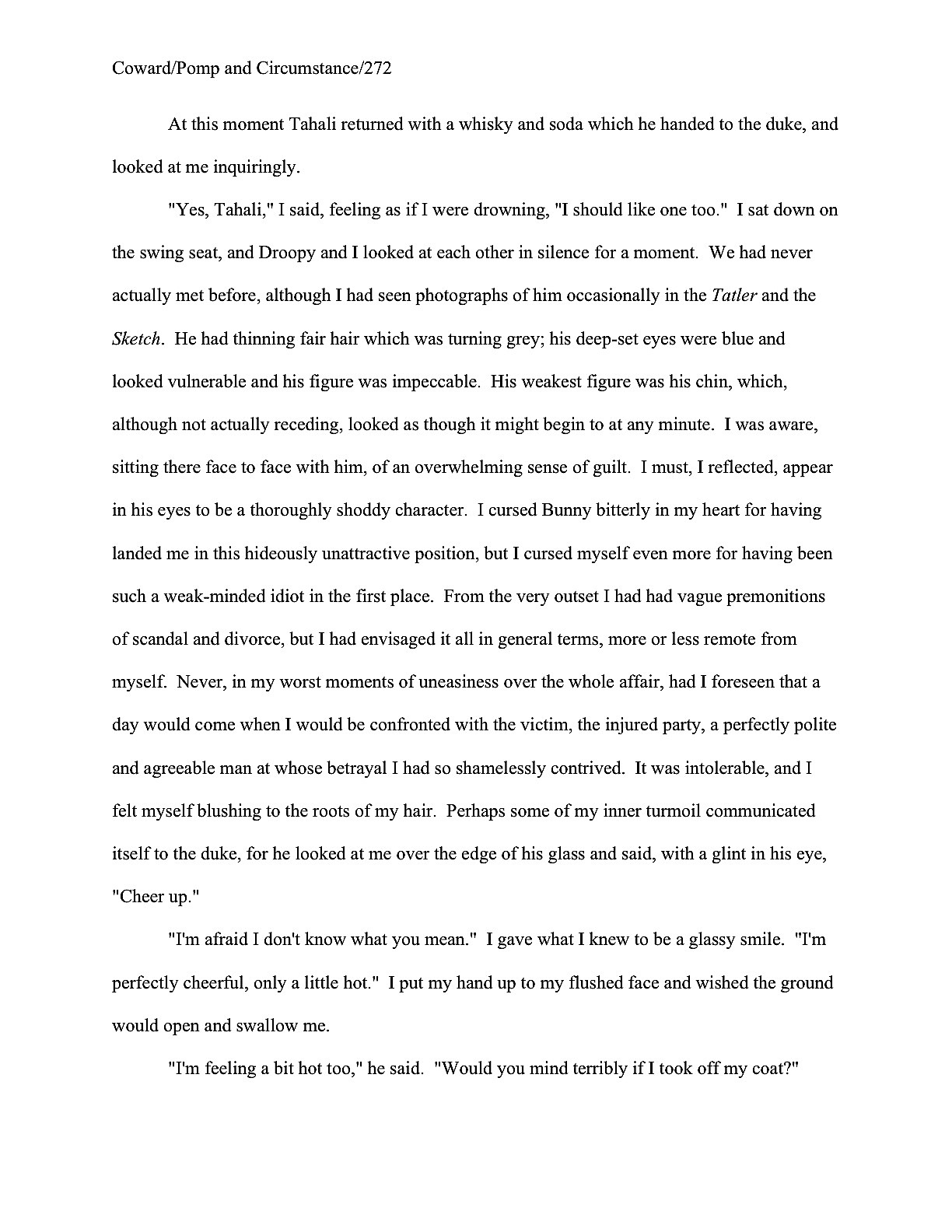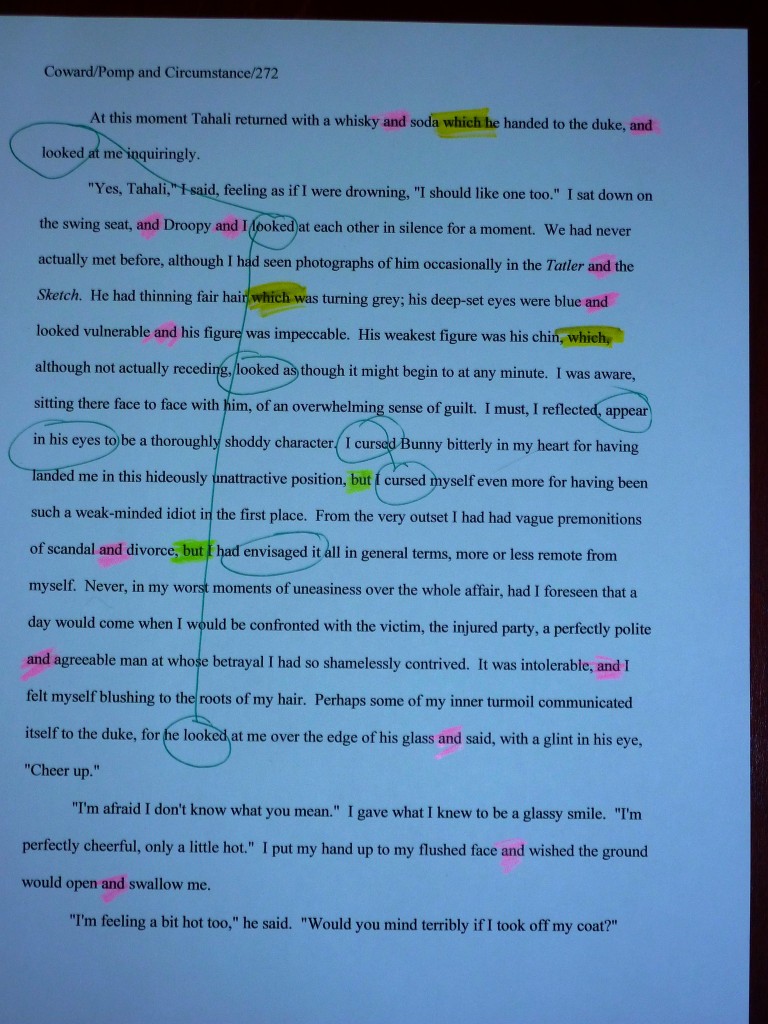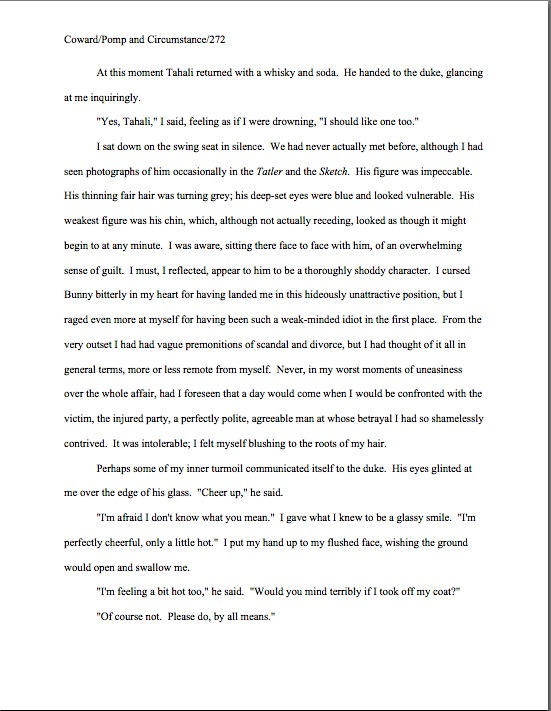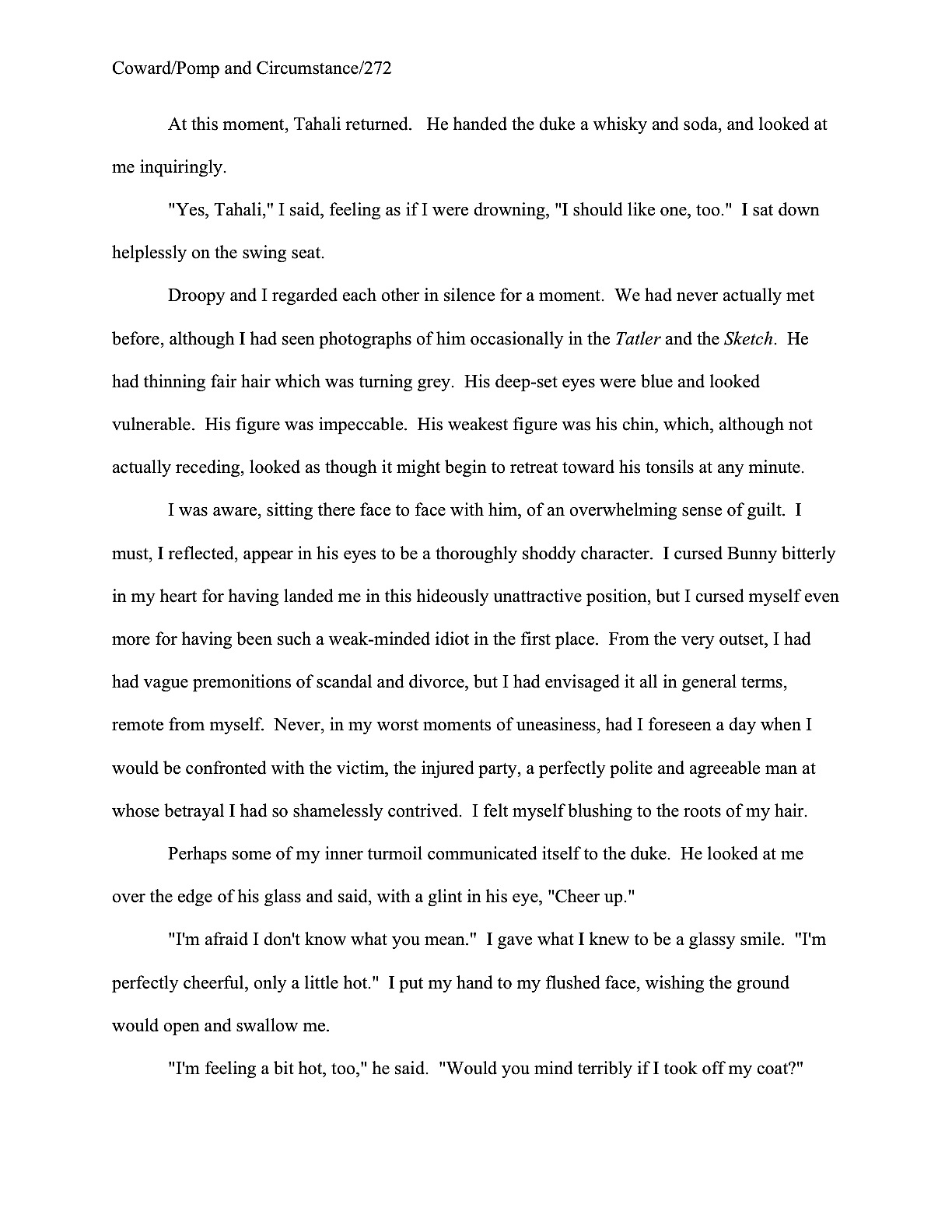Surprised not to see a post on formatting occupying this space, campers? You should be: for the past seven years, I have embraced the decline of the old year and the advent of the new as an opportunity to provide the members of the Author! Author! community with a solid explanation of something that new writers are simply expected to know how to do before they even consider approaching an agent. For some reason that defies human understanding, formatting a book manuscript or proposal as the pros do is implicitly regarded as piece of practical know-how the Literature Fairy bestows on talented writers at birth.
Perhaps my decades of experience as a writer and editor have skewed my sample, but in my experience, approximately no one is born with that knowledge. Innate literary talent has nothing to do with the learned skill of presenting one’s writing professionally, any more than having a naturally good ear for dialogue correlates with the ability to place a comma in the right place or wield a semicolon correctly.
Contrary to popular belief, quite a lot goes into writing a book other than inspiration, patience, and the willingness to sit in one place, typing your little heart out, for a year or two. So don’t panic, rookies: I shall be reviving my annual explanatory tradition next week.
For the next few days, though, I’d like to talk with those of you writing about reality — as memoir, as narrative nonfiction, as everyday life interpreted on the pages of a novel. It’s some of the most difficult writing to do well, yet strangely, we writers tend to discuss walking the truth tightrope far less amongst ourselves than the more fanciful aspects of craft.
Why? Well, fact-based fiction is considerably in less popular than it used to be, for one thing. While 30 or 40 years ago, someone who burned to write would have tended to churn out a slice-of-life piece the first time out — and, in all likelihood, seen it treated as a more serious literary production than a nonfiction piece covering precisely the same subject matter — new writers in recent years have been turning in greater numbers to genre fiction. It’s not that Millicent the agency screener no longer sees the vividly-rendered descriptions of living room slipcovers, meaningful glances, and tense non-verbal exchanges over WASPy Thanksgiving dinners of yesteryear cross her desk; it’s that realism in fiction has very largely been supplanted by fast-paced street fighting, a little light bondage, and sparkling vampires who, in defiance of tradition, wander about freely in daylight.
Nothing wrong with that, of course: publishing has always been a trend-oriented business. The explosion of YA, paranormal, and fantasy in recent years has brought incredible richness to all of those categories, partially through definitional expansion — YA in particular now regularly takes up subject matter that would have made even the most hardened high school librarian blush in the 1970s — and partially, let’s face it, through good writers rushing toward those readerships. Since the economic downturn began, even quite well-established mainstream and adult fiction authors have found themselves gravitating toward these categories — and if they haven’t of their own accords, their agents may well have suggested it. Trends, you see.
Memoir, too, has seen quite a sea change in recent years — and that has generated some immensely positive effects for memoir aficionados and writers alike. My personal favorite: like genre fiction, good memoir writing has very largely lost the stigma it once carried.
Does that sharp collective intake of breath indicate that those of you new to the joys and challenges of memoir were not aware that for many years, it was not considered high literary writing? While there have always been wonderfully-written memoirs, it used to be routine for fiction-lovers to sniff at them as literary efforts — and not only in private. It was an accepted species of snobbery. Blame Hemingway, Fitzgerald, Parker, and their ilk: for a good century or more, even the most beautifully-composed first-hand nonfiction account was generally dismissed in literary circles as a less serious endeavor — or at least one that deserved to be taken less seriously — than garden-variety slice-of-life fiction. Even, interestingly enough, if they covered essentially the same subject matter at a similar level of characterization.
Oh, you may laugh, but writers of promise (what ever happened to that lovely phrase?) were often actively discouraged from writing nonfiction accounts. “That’s journalism,” the literati would say. “You would have to approach your subject matter with absolute objectivity. If you wrote it as fiction, you could be as subjective as you liked! Not to mention using nicer language.”
Today, however, if a novelist snorts derisively at the very notion of telling some aspect of his life story in nonfiction form — or, to put it a bit more bluntly, by being up front about his being a character in his own book — readers and interviewers alike tend to respond in much the same way they would if he said that genre fiction contains no legitimate character development. They’d just assume that he doesn’t read very widely.
Because, let’s face it, there is great writing in every book category. Being a well-read person no longer means reading only certain types of books; the average reader’s tastes are now recognized as being fairly eclectic.
And hallelujah for that, I say. Pretending that consumers of literary fiction never cracked a graphic novel or fantasy was a strain on everybody, was it not? Although watching a literary snob swiftly shove the paperback he was avidly reading into a copy of PORTNOY’S COMPLAINT did constitute one of the great amusements of modern life, it’s one that I readily gave up in the service of an expansion of what counts as good writing.
The rehabilitation of the memoir also owes a debt to the narrative nonfiction revolution. Largely the brainchild of novelists, narrative nonfiction brought fiction techniques to real-world subject matter, presenting actual events accurately (ideally, verifiably so) while casting the storyline as a novel would, with a distinct narrative arc, intensive character development, and fleshed-out scenes. Like literary fiction, narrative nonfiction’s language not only conveys the facts; it evokes a mood. And, unlike objective journalism, narrative nonfiction voice often contains a distinct authorial point of view.
Admittedly, as is so often the case in the literary world, definitions of narrative (also known as creative or literary) nonfiction vary. There is a certain amount of debate, for instance, about how much factual research must go into narrative nonfiction: need it be sourced as exhaustively as a journalistic treatment of the same story? If the writer was not physically present for certain scenes, how much can she legitimately make up? How extensively can she embellish a scene? If the storyline includes dull or dramatically unsatisfying sections, may they ethically be glossed over?
A question that does not crop up much in the publishing world, however, but one often hears aspiring writers of the real asking at literary conferences: should a first-person narrative dealing primarily with events in the author’s own life should be categorized as narrative nonfiction or memoir? The confusion is understandable, of course — while a cookbook containing travelogue or extensive personal stories is fairly obviously a cookbook (the recipes are a dead giveaway), where the precise line falls between a personal essay (a distinct sub-category of narrative nonfiction) and memoir can be less clear-cut.
So why don’t the pros get thrown by the question? While a narrative nonfiction book and a memoir might well share a distinct story arc, a strong authorial voice and point of view, and pretty writing, narrative nonfiction tends to be more concept-oriented than memoir. While a personal essay might bring in scenes, events, and characters from the author’s life to speak to an overall philosophical, analytical, or even political point, a memoir would concentrate primarily upon telling the story.
Still confused, writers of the real? Let me put it another way: while the writer can be a character in both memoir and narrative nonfiction, a memoir is first and foremost that character’s tale. A narrative nonfiction treatment of the same set of events might well include the author’s activities, but it’s often as an observer of larger events. Think MIDNIGHT IN THE GARDEN OF GOOD AND EVIL or IN COLD BLOOD, or, better still, if you happen to be a Capote fan, HANDCARVED COFFINS: while the reader does learn quite a bit about the writer over the course of those narratives, the narrator is an observer of a larger play.
In a good memoir, however, the reader gets not only to see through the narrator’s eyes, but live through her flesh — not only for individual scenes tucked within a mostly descriptive narrative, but throughout the entire storyline. Indeed, a memoir can hardly be said to be successful on a writing level if the reader isn’t drawn into the action sufficiently to feel and think along with the protagonist.
Some eyebrows just hit some hairlines, I’m guessing. “But Anne,” sputter flabbergasted memoirists the English-speaking world over, “I hadn’t been thinking of myself as the protagonist of my story, as if I were writing a novel. I’m the narrator in a nonfiction book — naturally, I’m bound by the truth, but I’m telling the reader what happened, the way I would recount my adventures to a friend. Or to someone I met at a party. Or, ideally, to the agent of my dreams, shortly after she claps eyes on my query letter.”
That may well be your intent, memoirists, but to an editorial eye, those three audiences would call for three completely different levels of narrative intimacy. You would almost certainly include more personal details in regaling your friend with your adventures, would you not, than a total stranger at some dubious social gathering? And wouldn’t you be more inclined to make yourself look good as a character if you were trying to impress the hearer?
I get what you’re saying, though: aiming for a chatty, anecdotal-style voice is a fairly common memoir tactic. Common enough, unfortunately, that it can be a problematic narrative choice at submission time. I’ve said it before and shall no doubt say it again: just as real-life dialogue is often stultifying if transcribed directly to the printed page, the storytelling norms of everyday speech tend to be rather boring to read.
For starters, spoken sentence structure and word choice typically fall far below the standards of good memoir writing. Everyday speech also leans pretty heavily on stock phrases. New writers often don’t think about this, but using the same words, phrases, and kinds of sentences over and over again, as most of us routinely do when chatting with our friends, is rather tiring for the reader. Take, for instance, how I might legitimately describe something that happened to me recently should you be unfortunate enough to allow me to buttonholed you at a cocktail party whilst I was still miffed:
I’m starting to think my UPS man can’t read. Since getting to my front door from my studio means climbing down a couple of flights of stairs, I put a great big sign over my doorbell reading: PLEASE LEAVE PACKAGES ON RIGHT SIDE PORCH. Every time I have a package delivered, I put it in the address line. My side door has a sign reading: THANK YOU FOR DELIVERING PACKAGES HERE. Yet on each of the last three business days before Christmas, there he was, standing at my front door, ringing the doorbell over and over again, whistling, expecting me to climb down all of those stairs to give him a signature. No amount of shouting down from second-floor windows can make him budge.
Not precisely Dickens, is it? Or perhaps it is, if we consider the notoriously word-repetitious opening sentence of A TALE OF TWO CITIES:
It was the best of times, it was the worst of times, it was the age of wisdom, it was the age of foolishness, it was the epoch of belief, it was the epoch of incredulity, it was the season of Light, it was the season of Darkness, it was the spring of hope, it was the winter of despair, we had everything before us, we had nothing before us, we were all going direct to heaven, we were all going direct the other way — the period was so far like the present period, that some of its noisiest authorities insisted upon its being received, for good or for evil, in the superlative degree of comparison only.
Funny, certainly, but equally certainly stuffed with sweeping generalizations and eye-distracting word, phrase, and structural repetition. Not to mention being one lulu of a run-on sentence. Poor old Charles would have a heck of a time getting this opening past Millicent today — and not only because anything that read remotely like this would now be immediately dismissed as derivative of Dickens. That’s the trouble with those much-vaunted experiments in which disgruntled writers submit the opening pages of something like PRIDE AND PREJUDICE to agencies in an attempt to prove that good, solid writing no longer stands a chance, by the way: any Millicent who has been at it a while would recognize, if not the first few lines of P&P itself, then at least a manuscript attempting to copy Austen’s well-known satirical voice.
What was fresh in 1813 can hardly be called the cutting edge of literary style today. Had I mentioned that this has always been a trend-driven business?
My point, should we all care to veer back to it, is that while some stalwart soul with magnificent lungs might conceivably be able to utter Dickens’ epic opening sentence within a single breath to a crowd of hearers who would not necessarily wince at all of that textual repetition, it would be significantly harder for a reader to plow through a similar speech on the page. (As perhaps you recall from sophomore English class.) People in publishing would find it even more difficult: because most adult readers become bored and/or distracted by repetitious prose — if you don’t believe that, consider how annoying it’s been that I’ve kept using various forms of repetition throughout the last few paragraphs — agents and editors develop a sharp eye for it.
So, as it happens, do experienced Millicents. Now that Uncle Charles has been kind enough to irritate you into noticing repetition (there’s that darned word again!), let’s take a peek at how our favorite screener would read our earlier example of ordinary-voiced memoir writing:
I’m starting to think my UPS man can’t read. Since getting to my front door from my studio means climbing down a couple of flights of stairs, I put a great big sign over my doorbell reading: PLEASE LEAVE PACKAGES ON RIGHT SIDE PORCH. Every time I have a package delivered, I put it in the address line. My side door has a sign reading : THANK YOU FOR DELIVERING PACKAGES HERE. Yet on each of the last three business days before Christmas, there he was, standing at my front door, ringing the doorbell over and over again, whistling, expecting me to climb down all of those stairs to give him a signature. No amount of shouting down from second-floor windows can make him budge.
Awfully hard to follow what’s going on in the face of all of that visual noise, isn’t it? And that’s not even factoring in how high the generalization to detail ratio is here: as is so often the case with verbal storytelling, this paragraph is a festival of telling, not showing. That’s entirely appropriate for interpersonal communication, but not necessarily the best tactic for sharing a real-world story in print.
Why? Well, verbal anecdotes tend to be light on specifics, relying on swiftness of telling and sudden reversals to maintain momentum. As a result, they often don’t work well when translated directly to the page, which cries out for detail and fully fleshed-out interactions.
That often comes as a gigantic surprise to first-time memoirists — especially if they happen to be funny people. They expect, and with good reason, that the same story told in the same words will evoke the same reaction in any context. Yet as Millicent knows to her sorrow, many an anecdote that’s been slaying ‘em at parties for decades falls completely flat on the printed page.
A spoken anecdote’s success with hearers is frequently dependent upon the teller’s storytelling skills — a different set of skills than a writer wields, and requiring a significantly different sense of timing. That’s why, in case any of you had been wondering, a reader with a personal relationship with a writer of memoir (or personal essay, for that matter) will often have a significantly more positive response to reading that memoir or essay than a stranger would. The writer’s kith and/or kin will be mentally hearing the prose on the page in the writer’s spoken voice.
That’s impossible, obviously, for readers who don’t already know the author — a group which for your garden-variety aspiring writer includes Millicent, the agent of his dreams, his future acquiring editor, and, if we’re being honest, virtually everybody who will ever buy his book. I wish more aspiring memoirists thought about that; I can’t even begin to count how often I’ve seen great personal stories not be able to fly as memoir, simply because the narratives relied upon the reader to imagine tone and delivery style that just didn’t show up on the page.
Celebrity memoirs, particularly those written by comedians, are notoriously susceptible to this pitfall: if the reader can imagine the text read in the celebrity’s voice, it’s funny, but otherwise, the prose just sits on the page, unremarkable, crying out for a dramatic reading. These literary efforts represent, I think, a fundamental pessimism about the possibilities of readership. Presumably, the celebrity, the acquiring editor, and any ghost who might happen to have contributed some text to the festivities (allegedly) all believe in their heart of hearts that absolutely no one who has not heard the author’s speaking voice often enough to be able to produce a spontaneous and reasonably accurate impression would ever consider picking up his book. Were I a celebrity with something to say, I might find that a trifle depressing.
While stand-up comics and their ilk can indeed sell books that suffer under this presumption, it’s not the best strategic move for writers trying to make a name for themselves. Millicent does not use a smile for her umbrella, typically; she’s seen too many attempts at humor die a miserable death on the submission page. Unless you are absolutely positive that something is funny — and would be funny to a complete stranger who had never heard you utter a syllable out loud — you might want to consider punching it up. If you’re not sure, track down some objective feedback.
And don’t try to wiggle out of it by saying that your witticisms left your kith and kin rolling in the aisles. “But my mother thought it was hilarious!” has literally never convinced an agent or editor — or anyone else, for that matter — that an anecdote was funny if it didn’t elicit a chuckle on a first read. If there’s any rule to which those who work with writers cling tenaciously, it’s that the person who gave a writer birth — or shares his bed, or has been her best friend since the second grade — is not the ideal first reader for a memoirist. They’re simply too likely to read something into the text that isn’t actually on the page.
That’s true to a lesser extent of any form of writing, of course, but for memoir, the response of someone who knows the writer is likely to deviate even more wildly from the average reader’s. Even if your chum/relative/guy unwise enough to say, “Oh, you write? I’d love to read something of yours sometime,” isn’t actually a character in your memoir, s/he will already have formed opinions about you as a person, right? That relieves the narrative of the burden of character development for you, at least for that particular reader. Ongoing relationships also, more often than not, cause too-close first readers to peruse the text with a too-indulgent eye — or a too-critical one.
And although your kith and kin are no doubt delightful people, charming to know in any other context, when they are reading your memoir, they will probably also fill in necessary logic, should your narrative have happened to omit it. Indeed, many first-time memoirists so firmly picture their kith and kin’s past reactions to their verbal anecdotes that they elect to leave out connective logic, description, and character development requisite for an impartial reader to follow what’s happening.
Much to Millicent’s chagrin, many of these well-meaning writers — who, after all, are quite sensibly, they think, relying upon their past storytelling experience in constructing their memoir voices — will believe that telling their tales in a conversational manner will be an asset to the story. You wouldn’t believe how many memoir submissions open something like this, as if the narrator were addressing a close friend:
You’re not going to believe this, but that crazy UPS man appeared on my doorstep again. You know, the one who believes that the only physical space in the universe where it’s possible for a human being to sign for a package is the front doorstep?
I could go on, but why? There’s nothing wrong with the phrasing here, but already, the anecdote is predicated on the assumption that the reader will be willing to accept this rushed, limited back-story as a legitimate means of setting up what’s about to happen. Instead of showing us precisely how and why the guy’s nutty — or giving us enough insight into the narrator’s character to be able to discern whether we should take her word for this casual diagnosis — the text just expects us to try to picture what’s already happened before the story began, even though we don’t have access to enough information to be able to guess.
But that’s not the usual narrative presumption in a verbal anecdote, is it? We seldom assume that total strangers will already know what’s been going on in our lives, but fortunately for speed in storytelling, we’re often in the comparatively easy narrative position of relating our anecdotes to people who have already heard about our earlier interactions with the same characters. In this case, if I were actually telling this story to a friend (let’s call her Antoinette) I would have already regaled with my earlier interactions with the UPS man (which were positively hair-raising, incidentally). She also might have seen first-hand that since I’ve been walking with a cane since a car crash, hobbling down a flight of stairs, much less two, might be a trifle dangerous.
Oh, hadn’t I mentioned that any of the three times I shared this anecdote as memoir text? Changes your mental image of what’s going on, doesn’t it? An objective first reader might have caught that, but Antoinette probably wouldn’t.
That expectation of familiarity frequently haunts the anecdote-teller committing her tales to the page: the verbal anecdotalist can legitimately construct a tale under the assumption that the hearer will remember past accounts. Had Antoinette chatted with me on any day since midsummer, she might well have stood, glassy-eyed, while I treated her to a vivid account of how this sterling deliveryman raised my hair, as well as my hackles.
In essence, I am expecting Antoinette to follow a serial already in progress; woe to her if she had not paid attention to the earlier installments. She might have, but I can tell you now that Millicent hasn’t.
Yet you’d be astonished at how many memoir submissions toss poor Millie into the middle of an ongoing series of anecdotes. Perhaps not as obviously as Antoinette was, but honestly, would a screener not need to have pre-knowledge of the writer’s life to be able to make sense of a first paragraph like this?
I walked into my usual bar, ordered my usual drink, smiled at the lady who’s always sitting on that stool where the bar bends. So far, a completely ordinary day.
“I have no doubt of that,” Millicent sighs, “but since neither the reader nor I have any idea what your ordinary days are like, you’re leaving us in the dark here, narratively speaking. I suppose I could make the effort of conjuring up what the bar looked like, smelled like, and felt like underfoot, but that’s not the reader’s job, is it? Nor does my job description compel me to guess what you like to drink, the lady’s back-story, or even what time it is when you walked into the bar, so I can form no opinion about whether I should draw any conclusion whatsoever from your day’s including this activity. Next!”
Why, yes, that’s quite a bit of reaction to only two sentences of text, now that you mention it. But tell me truthfully: if you were Millicent, would you keep reading?
Yes, yes, I know: that’s an extremely difficult question for a memoirist to answer, and probably one that calls up an emotional response. Not only does it require an objective assessment of how the story’s being told here — an objective assessment which, by definition, no memoirist can possibly derive from her kith and kin, who will automatically bring their knowledge of you to the text — but it implies a critique of the events described, too, doesn’t it?
“How dare you?” the memoirist shouts. “Are you calling my story too boring to maintain anyone’s interest? Or are you saying that it’s badly written?”
Neither, necessarily. From Millicent’s perspective — which, lest we forget, will be shared by her boss, an acquiring editor, and the future readers of your book — the question of whether to read on past this paragraph has nothing to do with what’s actually going on in the scene. So far, all that’s happened is that the narrator has walked into a bar and ordered a drink: not a lot to judge there. The narrative style is plain, but perhaps that’s appropriate for the book’s subject matter and target audience.
“Wait a sec,” our beleaguered memoirist interrupts. “Target audience? What does that even mean for a memoir?”
Glad you asked. Most first-time memoirists don’t give any thought at all to who will want to read their books, much less who will be willing to shell out cash to read them. Or, if they do ponder it, the audience they have in mind consists largely of, you guessed it, the array of kith and kin who have already heard at least some of the memoir’s storyline in anecdotal form.
Now, I’m not saying that your Aunt Sadie, your best friend from work, and your significant other won’t be delighted enough to see you in print at last to rush out and buy your book. They probably will — especially if you’re clever enough to explain to them now that published authors get very few free copies; any you distribute to your loved ones gratis will not count toward your sales totals, and you may actually have to purchase them yourself. The sooner the fine folks who love you come to accept that the best way to support an author one happens to know personally is to buy their work, the happier you will be as a working writer.
But as your literary cheerleader and friend in the biz, is it wrong of me to hope that the people who already know you will not make up the entirety of the readership for your memoir? You want complete strangers to be enchanted with your prose, right? Presumably, if you didn’t want to reach readers outside your doubtless warm intimate circle, you would not be going to the effort and taking the considerable emotional risk of sending your work out to agents.
Especially because that risk is quite a bit higher when it’s your own story told as nonfiction, isn’t it, memoirists? I’m inclined to think, then, that you’re pretty committed to reaching some sympathetic strangers.
I applaud your bravery, but that means, in practice, that objective readers’ opinions of your memoir matter. Inevitably, like any book, your memoir will appeal to some readers and not others.
And before you get your mouth fully open to retort, let me stop you from asserting that anyone interested in good writing will like your book because it is a good story well written. I can tell you now that your future agent and editor will be amused, not convinced, by that argument.
Why? Well, from a publishing perspective, there is no such thing as a universally-appealing piece of writing. Some readers are drawn to one type of story, others another. That’s just a fact of pushing books. Even if you happen to have produced a memoir that both taps into an under-mined literary niche and catches the public imagination at just the right time (like, say, ANGELA’S ASHES), your future agent and editor will not think of it as just good writing about your life.
How will they think of it? As a memoir about a specific place and time, told in a specific voice — and as a book that will need to be sold to readers already in the habit of reading similar books.
“Similar books!” memoirists everywhere shout, insulted. “But my story’s unique! So is my narrative voice. How could any reader possibly form a sense of whether he will like it without reading it?”
Yes, yes, you’re a snowflake, but think about it: don’t you decide whether to pick up a book in a bookstore or search for it online without having read it? Don’t you as a reader gravitate toward certain types of narrative, particular varieties of story, a specific species of tone? Don’t you in fact do it all the time?
So does everybody else — including agents, editors, and anyone in a position to help you get your book published traditionally. No agent or editor, even those who handle nothing but memoir, will be attracted to every conceivable personal story that’s written well. Like every other individual reader currently milling about the earth’s crust, they have individual preferences.
And — brace yourselves; this next bit often comes as a shock to first-time memoirists — not all of those preferences concern writing style, or even having a compelling story to tell. Agents, editors, and memoir readers in general also tend to gravitate toward stories about specific types of experiences. From the publisher’s point of view — and thus an agent’s — memoirs are always about something other than the author’s life.
Mostly, I suspect, because to anyone familiar with the concept of a memoir, the statement “What’s the book about? Why, it’s about the author’s life!” is self-evident. It’s also self-evident to Millicent that not every interesting life translates easily into a page-turning memoir.
All of that can be difficult for writers fond of slice-of-life fiction to accept. “Isn’t the point of memoir,” they demand, and who could blame them? “to hold, as ’twere, the mirror up to nature? Good books about ordinary life are valuable. If a well-written story happens to be true, it’s automatically going to appeal to memoir readers, right?
Actually, no: thousands of memoirs come out every year, and by definition, all are about real events, yet only a few capture large readerships. Partially, that’s a matter of scarce marketing resources; it’s also often a matter of luck. Sometimes, it’s a function of the writing, but again, no publisher with her head screwed on straight would dream of promoting a memoir by saying, “Oh, it’s really well written. And had I mentioned that it was about the author’s life?”
Of course it is, but at the risk of repeating myself (oh, you thought I’d dropped my earlier point about textual repetition?), not every true story is equally appealing to every reader. Truth is a necessary attribute of memoir, not an optional extra. So are solid, clear writing and a dramatically-satisfying story arc.
If that last paragraph left you grumbling, well, you’re not alone. Most aspiring memoirists think of their books primarily as opportunities to share their life stories with a potentially admiring world. To them, the fact that they are telling their truth couldn’t possibly be more important: who in her right mind would put herself through the genuinely emotion-wracking process of reliving her ups and downs vividly enough to write about them well unless she felt her story burning inside her?
I’m entirely sympathetic to that yearning to shout the truth to the skies. However, as a memoirist myself — and as an author who has written a minor political celebrity’s memoir as well, a fascinating exercise in mind-melding — I know that there’s considerably more to constructing an emotionally and factually truthful memoir than simply telling the reader what happened. It’s not as though one can simply provide a list of events and expect the reader to extrapolate human feeling. A memoirist has to dig deep, be profoundly honest with himself — and then figure out what does and does not belong in the book.
Didn’t see that last bit coming, did you? As much as we memoirists like to claim the mantle of truth, not everything that occurs in even the most fascinating person’s life will be gripping on the page. Part of the art of memoir lies in selectivity — a good memoir tells the story of a particular part of a particular life, not everything that happened. That means, at both the book structuring and writing stages, you will need to weed out actual events that undoubtedly happened, ones that may in themselves be interesting, but do not advance the story arc of the book.
Let’s pause for a moment to consider that; it’s is an aspect of memoir-writing that often confuses those new to the game. Telling the truth, the whole truth, and nothing but the truth may work admirably on the witness stand, but the goal of a memoir is not simply to provide the reader with either a complete transcript or general summary of the author’s life. It’s to recount a specific set of connected events in a truthful, well-written, and entertaining manner, in a narrative voice likable enough that the reader will want to accompany the narrator on that absorbing journey.
That’s necessarily the case, because, let’s face it, the alternative would not be much fun for the reader. In fact, it could be a heck of a lot of work: in an indiscriminate, sprawling memoir, the reader must try to determine which of many protagonist-centered activities are important to the central storyline. Indeed, it’s not at all uncommon for a loosely-organized memoir manuscript not to have a clearly-defined central storyline at all, for the exceedingly simple reason that most new memoirists don’t think of their lives that way.
But if you, the narrator, don’t know what the core story arc of your memoir is, how can a reader possibly figure it out? And is it really the reader’s job?
So I ask you again: what is your memoir about?
While you’re pondering that gargantuan and quite possibly terrifying question, let me share my favorite analogy for creative selectivity in nonfiction: throwing a stone into an otherwise still pond. That will cause a series of concentric ripples, right, altering the surface of the pond over time? A well thought-out memoir will depict the pond, as well as the thrower and the flinging process, following those many small waves as they change everything in their path.
How might that translate into a story arc derived from a rich and diverse life story? Think of the pond and its environs as your day-to-day life prior to a defining moment or decision. In order to gain a clear sense of just how much throwing that stone disturbed the pond, the reader is going to need to experience it as you did: the sights, the sounds, the smells, the feelings, what you loved and wanted, what you feared and avoided.
You could simply summarize all of that, I suppose, but wouldn’t the reader gain a stronger impression of what it was like to be you standing on the shore, weighing whether to toss that rock, if you conveyed your experiences via small, evocative details and fully fleshed-out scenes? With all of those sensations filtered through your psyche and perceptions, wouldn’t the reader get to know you pretty well as the protagonist of your own story?
Once you’ve established yourself as an interesting person in an interesting situation, and an intriguingly observant one at that, the reader is going to care about where and whether you cast that rock — or, in a story about being overwhelmed by larger events, about how you were flung bodily into the middle of that pond. How did your life change as a result? What did you do in response? What did you want to have happen, and what barriers did you face?
Starting to sound much more like a cohesive storyline, isn’t it? Much as in fiction, figuring out what is and isn’t central to the overall story you’re telling is not merely a matter of explaining what happened: it’s a matter of identifying the most important conflict the protagonist faces, what obstacles she must overcome, and showing the reader how that conflict played out.
That conflict, my friend, is what your memoir is about. It’s every bit as unique as you had originally thought; it’s merely structured in a manner that’s easier for a reader who doesn’t already know you to follow.
Does it make more sense now that “What is your memoir about?” would be the first thing Millicent, her boss, your acquiring editor, and the reader who will ultimately buy your book would want to know? At least, unless you have had the foresight to have established yourself as a celebrity, giving rise to a reasonable expectation that the very sight of your name on a book jacket will make your target reader gasp with incredulous pleasure and reach for the volume. Barring that kind of extremely helpful platform, it honestly does make sense that your future publisher will want to aim your book at readers most likely to respond positively to it.
Which is why, in the extremely likely event that those of you grumbling your way through writing a book proposal had been wondering, agents and editors expect memoirists, like all hopeful nonfiction writers, to give some serious advance thought to who is likely to buy the book and why. It’s also part of the reason memoirs — again, like other nonfiction — are typically sold in the U.S. not based upon a full manuscript, but merely upon a book proposal and a sample chapter. In all likelihood, your acquiring editor will want to have some input into the selection process, to help define your story arc in the manner most likely to capture the interest of readers already buying similar stories.
But let me guess: you’d been thinking of the proposal as just an annoying hoop through which you would have to leap in order to land an agent for your story, right? Believe it or not, the proposal’s requirements genuinely are intended to help nonfiction writers think about their books — and for memoirists to think of their life stories — not merely as writing about facts, but as gripping stories aimed at a specific readership predisposed to like ‘em.
I wouldn’t lie to you about that; I’m a memoirist, selectively drawing from the world as I find it to create a narrative true on a wide variety of levels. Keep up the good work!








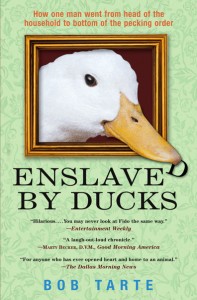 When Bob Tarte left the city of Grand Rapids, Michigan for the country, he was thinking peace and quiet. He’d write his music reviews in the solitude of his rural home on the outskirts of everything.
When Bob Tarte left the city of Grand Rapids, Michigan for the country, he was thinking peace and quiet. He’d write his music reviews in the solitude of his rural home on the outskirts of everything.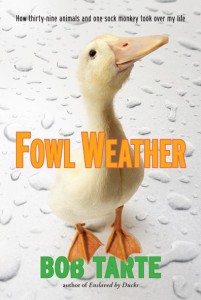 Bob Tarte’s second book, Fowl Weather, returns us to the Michigan house where pandemonium is the governing principle, and where 39 animals rule the roost. But as things seem to spiral out of control, as his parents age and his mother’s grasp on reality loosens as she battles Alzheimer’s disease, Bob unexpectedly finds support from the gaggle of animals around him. They provide, in their irrational fashion, models for how to live.
Bob Tarte’s second book, Fowl Weather, returns us to the Michigan house where pandemonium is the governing principle, and where 39 animals rule the roost. But as things seem to spiral out of control, as his parents age and his mother’s grasp on reality loosens as she battles Alzheimer’s disease, Bob unexpectedly finds support from the gaggle of animals around him. They provide, in their irrational fashion, models for how to live.




